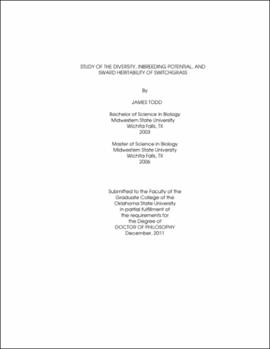| dc.contributor.advisor | Wu, Yanqi | |
| dc.contributor.author | Todd, James | |
| dc.date.accessioned | 2013-12-10T18:04:39Z | |
| dc.date.available | 2013-12-10T18:04:39Z | |
| dc.date.issued | 2011-12 | |
| dc.identifier.uri | https://hdl.handle.net/11244/7752 | |
| dc.description.abstract | Scope and Method of Study: Study the diversity of 56 genotypes of switchgrass from different regions of the US using AFLP. Study the heritability of two populations of Switchgrass (SL-93 C2 and NL-94 C2 ) in swards. Investigate 3 different bag methods (paper, microfiber and cotton muslin) to evaluate inbreeding seed yield of two populations (Kanlow and Alamo) of S2 switchgrass. | |
| dc.description.abstract | Findings and Conclusions: The upland and lowland accessions clustered according to ecotypes, with one exception (TN104). Genetic similarity coefficients among the accessions ranged from 0.73 to 0.95. An analysis of molecular variance (AMOVA) was performed using GenAlEx (ver. 6.3) resulting in a significant difference (a=0.05) between the upland and lowland genotypes. The trnL marker confirmed that TN104 was a lowland genotype, but the trnL marker identification of upland and lowland genotypes was not consistent with the AFLP in two germplasm (Miami and AR4). From the heritability study, the drought of 2011 affected the heritability estimates. The variance component estimates for 2008-2011 for NL-94 and SL-93 were 0.08 and 0.08 respectively compared to 2008-2010 which were 0.16 and 0.07 respectively per sward plot. The per family mean estimates for 2008-2011 for NL-94 and SL-93 were 0.58 and 0.59 respectively compared to 2008-2010 estimates which were 0.70 and 0.46 respectively. The parent offspring regression estimates for 2010-2011 for NL-94 and SL-93 were 0.10 and 0.31 respectively. Only one bag type in 2010 had a significant difference (microfiber) and it is difficult to tell if that difference is not caused by bag failure. Six SSR primer pairs were used to confirm selfed progeny identity by determining if all progeny alleles matched its maternal parent. Of the 2008 Kanlow offspring 23 were inbreds (25.3%) and of Alamo 33, were inbreds (33%). Of the 2009 Alamo plants, 24 (23.07%) were inbred and 133 (82.1%) Kanlow plants were inbred. Of the 2010 Alamo plants 10 were inbred (38.56%), and of the 2010 Kanlow plants, 5 plants were inbred (31.25%). | |
| dc.format | application/pdf | |
| dc.language | en_US | |
| dc.rights | Copyright is held by the author who has granted the Oklahoma State University Library the non-exclusive right to share this material in its institutional repository. Contact Digital Library Services at lib-dls@okstate.edu or 405-744-9161 for the permission policy on the use, reproduction or distribution of this material. | |
| dc.title | Study of the diversity, inbreeding potential, and sward heritability of switchgrass | |
| dc.contributor.committeeMember | Klatt, Art | |
| dc.contributor.committeeMember | Anderson, Michael P. | |
| dc.contributor.committeeMember | Goad, Carla | |
| osu.filename | Todd_okstate_0664D_11838.pdf | |
| osu.accesstype | Open Access | |
| dc.type.genre | Dissertation | |
| dc.type.material | Text | |
| dc.subject.keywords | aflp | |
| dc.subject.keywords | biofuel | |
| dc.subject.keywords | heritability | |
| dc.subject.keywords | inbreeding | |
| dc.subject.keywords | switchgrass | |
| thesis.degree.discipline | Crop Science | |
| thesis.degree.grantor | Oklahoma State University | |
